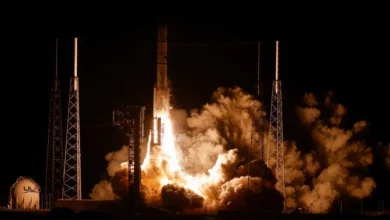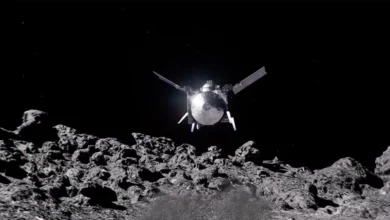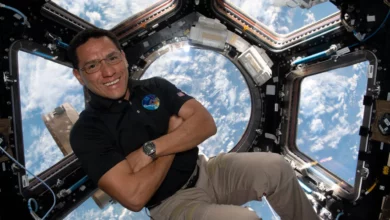
CNN — The Artemis I rocket will get its third launch attempt on Tuesday, September 27, but Tropical Depression Nine could change that.
The 70-minute launch window opens at 11:37 a.m. ET and the Space Launch System rocket and Orion spacecraft continue to sit on the launchpad at Kennedy Space Center in Florida.
Concerns over the weather system forming in the Caribbean put the weather conditions at only 20% favorable for a launch. The current path of the tropical depression puts the storm on track to impact Cuba and Florida early next week.
Given the uncertainty in the storm track, intensity and the arrival time, the Artemis team will use the latest data to inform their decision, said Mike Bolger, manager of NASA’s Exploration Ground Systems Program.
The Artemis team is closely monitoring the weather and will make a decision on Saturday.
“Deep tropical moisture will spill across the Spaceport Tuesday, with widespread cloud cover and scattered showers likely during the launch window,” according to a forecast released by the US Space Force on Friday.
Constraints on the launch require that the Artemis I mission does not fly through any precipitation. The launch constraints are designed to avoid natural and rocket-triggered lightning strikes to in-flight rockets, which could cause damage to the rocket and endanger public safety, according to the Space Force.
Rocket-triggered lightning forms when a large rocket flies through a strong enough atmospheric electric field, so a cloud that is not producing natural lightning could still cause rocket-triggered lightning, according to the Space Force.
If the rocket stack needs to be rolled back into the Vehicle Assembly Building at the Kennedy Space Center, the process could take several days.
The rocket stack can remain at the pad and withstand winds up to 85 miles per hour (74.1 knots). If the stack needs to roll back into the building, it can handle sustained winds less than 46 miles per hour (40 knots), Bolger said.
Assessing crucial data
Meanwhile, the Artemis team is encouraged after “a really successful tanking test,” and “the rocket is looking good for upcoming launch attempts, said John Blevins, SLS chief engineer at NASA’s Marshall Space Flight Center in Huntsville, Alabama.
The crucial fueling test for the mega moon rocket met all of its objectives on Wednesday, despite two separate hydrogen leaks that occurred.
The purpose of the cryogenic demonstration was to test replaced seals and use updated, “kinder and gentler” loading procedures of the supercold propellant that the rocket would experience on launch day.
NASA engineers detected a liquid hydrogen leak during the test that had “the same signature” as a leak that prevented the September 3 launch attempt. However, their troubleshooting efforts allowed the team to manage the leak.
The team was able to completely fill the core stage with liquid oxygen and liquid hydrogen. They also completed an engine bleed test, which conditions the four engines and brings their temperature down prior to launch. (The mission team scrubbed the first Artemis I launch attempt on August 29 largely due to an issue with a faulty sensor that occurred during the bleed.)
A hydrogen leak detected on the 4-inch quick disconnect line for the engine bleed went above the 4% threshold during a pre-pressurization test. This quick disconnect line carries liquid hydrogen out of the engines after they have run through the engines and chilled them. But the leak rate lowered on its own.
Additionally, the Artemis team has received approval from the Space Force for the launch attempt on September 27 and a backup date of October 2.
The Space Force oversees all rocket launches from the United States’ East Coast, including NASA’s Florida launch site, and that area is known as the Eastern Range. The officials at the range are tasked with making sure there’s no risk to people or property with any launch attempt.
After receiving detailed data from NASA, the Space Force issued a waiver for the launch dates.
The inaugural mission of the Artemis program will kick off a phase of NASA space exploration that intends to land diverse astronaut crews at previously unexplored regions of the moon – on the Artemis II and Artemis III missions, slated for 2024 and 2025, respectively – and eventually deliver crewed missions to Mars.





